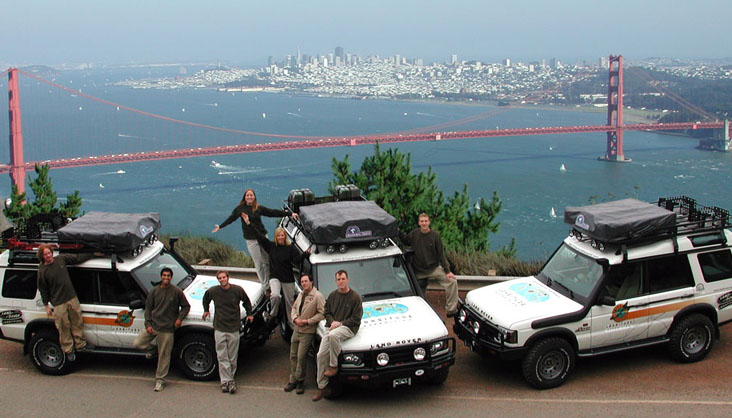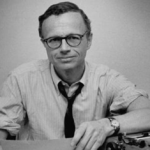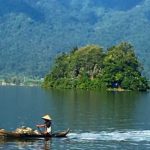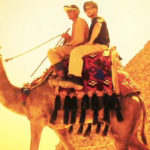Friends and vagabonders,
Fall promises to be an exciting season for me this year, as I will be departing to drive across the Americas as part of a Land Rover-supported expedition that will eventually drive around planet Earth along lines of longitude. The name of this expedition (and nonprofit organization) is “Drive Around the World” — and more information on this journey can be found online. Briefly, it is an expedition to raise money and awareness for Parkinson’s Disease research through the Parkinson’s Institute, while (through an interactive education program) raising geography awareness among American schoolchildren. (And, of course, we aim to have lots of fun and get into plenty of adventures.)
In December, I will write about the Central America leg of this journey for Slate.com’s “Well Traveled” section, and shorter dispatches will be immediately available through my weblog. In addition to this, I will be editing daily journals from our nine-person expedition team as we travel, and these dispatches can be found on the Drive Around the World website.
The expedition will start in San Francisco, California, and head south through Mexico and Central America. From Panama, we will ship the vehicles to Ecuador (thus avoiding the Darien Gap), then continue south along the Andes and the western coast of South America, all the way to Tierra del Fuego, the southernmost part of the Americas. At that point it is likely that I will part ways with the expedition (to leave on a journalism fellowship) as the vehicles ship to Australia. From Australia, the expedition will continue on to Indonesia, Singapore, Malaysia, Thailand, Cambodia, Laos, Myanmar, Bangladesh, India, Sri Lanka, Nepal, China, Kyrgyzstan, Kazakhstan, and Russia. In Russia the team will travel over some of the most isolated parts of Siberia en route to the Kamchatka Peninsula, where the vehicles will be shipped to Prudhoe Bay, Alaska. From there, Drive Around the World will travel full-circle to San Francisco via Alaska, Canada, and the Pacific Northwest. The planned time for this transit is nine months, covering nearly 35,000 miles.
Ironically, this journey won’t really count as Vagabonding. In my Vagabonding book, I encourage folks to travel slowly and privately, be spontaneous, and avoid overplanning. Thus, at 34 countries in nine months, Drive Around the World will be moving too fast to count as vagabonding. And, with Land Rover sponsorship and a film crew onboard, the expedition won’t be too private, either. Moreover, given the bureaucratic rigors of a vehicle-dependent expedition, intricate planning and itineraries will at times be necessary. So, in many ways, my latest adventure will often deviate from the advice of my latest book: It will be more like a National Geographic TV special than vagabonding voyage. And, after seven or so years of nonstop vagabonding, I welcome the novelty of these new travel twists.
Yet in many ways, Drive Around the World will indeed hold true to the vagabonding ethic. As we travel, we hope to wander off the beaten path and interact with locals as much as possible. We will remain open to new travel lessons and experiences, and we will spend our money almost exclusively at the grassroots level of local economies. We hope to seek adventure, keep things real, and be creative as we drive our way around the world. We hope to come home enlightened and inspired and changed. And through our education program, we hope to promote travel as a way to learn about other cultures, broaden people’s horizons, and improve the way we see the world. Stay tuned as the expedition gets underway.
Elsewhere this month, I have a story appearing in the latest travel-lit anthology from Lonely Planet, entitled The Kindness of Strangers. Edited by Salon.com vet (and LP global travel editor) Don George, this book explores the unexpected human connections that so often transform our travel experiences. Notable authors in the anthology include Jan Morris, Pico Iyer, Tanya Shaffer, Dave Eggers, Tim Cahill, Stanley Stewart, Jeff Greenwald, and Simon Winchester. My contribution is the humor-tinged Lebanon story, “My Beirut Hostage Crisis”.
Finally, on the Travel Writers portion of my website, I’ll be introducing four new interviews this season, including Q&A sessions with What Every American Should Know About the Rest of the World author Melissa Rossi, Moon Handbooks author Wayne Bernhardson, Islands in the Clouds author Isabella Tree, and novelist/travel-writing teacher James Sturz.
I’ll post another update in January; until then, keep an eye on my daily weblog!
Cheers — and happy vagabonding,
Rolf





